Summary The veterinary activities were successful during the month of September, the veterinary unit in Mara managed to attend to all the reported cases in Mara and Naivasha areas
Summary
The veterinary activities were successful during the month of September, the veterinary unit in Mara managed to attend to all the reported cases in Mara and Naivasha areas. Some of the cases attended to include an elephant calf which had a tight snare cutting through the neck muscles causing a lot of pain and haemorrhage. A number of zebras with snares and other forms of injuries were also attended to in Naivasha area during September as reported below.
Rescue and treatment of a common zebra trapped by a piece of plastic in Longonot area, Naivasha.
The zebra was sighted in a herd of about 6 other zebras near Kedong ranch at a GPS location; 37M0217487; UTM9908772, it was unable to walk properly and was in severe pain because the piece of plastic was cutting right through the muscles causing intense pain. It had even started loosing its body condition. It was captured by darting using 5mgs of etorphine hydrochloride combined with 60mgs of xylazine hydrochloride on the right thigh region. The plastic was cut off using a sharp knife and removed. It had cut through the muscles and inflicted a severe wound on the right front leg. 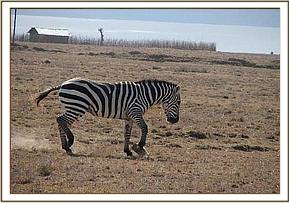

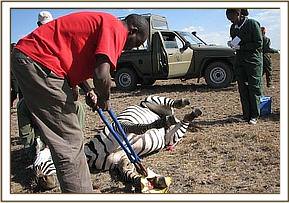

The wound that was inflicted on the foot was cleaned and treated routinely using 10% hydrogen peroxide and application of a tincture of iodine solution, other antibiotics and antinflammatory drugs were also administered intramuscularly. Ticks and blood samples were collected and preserved for laboratory analysis. It was later revived from anaesthesia using 12mgs of diprenorphine combined with 10mgs of atipamezole hydrochloride administered through the jugular vein and released back to the wild feeling relieved. It had good chances of recovery from the injury after removal of the plastic and treatment of the wound.
Treatment of a common zebra injured in Kigio Wildlife Conservancy, Naivasha
This was a case of an adult female zebra that was found limping and unable to graze freely within Kigio wildlife conservancy. It had a hard swelling on the carpal joint of the right front leg, the cause of the swelling was not known. The vet team decided to capture it and examine the leg which seemed to be dislocated or had joint arthritis.
It was then captured by chemical immobilization by darting using 5mgs of etorphine hydrochloride combined with 70mgs of Xylazine hydrochloride and darted on the right thigh, the drug took about 6 minutes to take effect.
The joint was palpated, flexed and examined, it was found that the animal had a dislocation sometimes back but this had partially healed over time, the swelling was of joint capsule inflammation and bone swelling. It was still painful but was progressively healing. The animal was treated using long-acting antibiotics and dexamethasone administered intramuscularly to treat the infection and reduce inflammation, pain and swelling. 

The animal was then revived from anaesthesia using 24mgs of diprenorphine hydrochloride and 5 mgs of atipamezole hydrochloride administered through the jugular vein. The prognosis was good and it had good chances of healing.
Removal of a wire snare and treatment of an elephant calf in Ngiro-Are area, Mara Triangle
This was a case of one year old female calf which had a very tight snare around the neck, the wire was cutting through the neck muscles causing a deep severe wound with a lot of haemorrhage. The wound round the neck was still fresh with minimum infection. The calf was in much pain due to the constant irritation by the wire as it moved. The calf was found in a family of 5 elephants in an open plain near Serena lodges.
Chemical immobilization and treatment
The vet team decided to capture the calf, remove the snare and treat the inflicted wound. It was expected that once the calf is darted, the mother would not go away and let people handle the calf so it was suggested that the calf and the mother be darted at the same time to avoid resistance from the mother. Other members of the elephant family were expected to leave once the two were immobilized.
Both the mother and the calf were darted at the same time starting with the calf then the mother, darting was done from a vehicle. The calf took about 7 minutes to become recumbent, then the mother went down a few minutes later.
Unfortunately the matriarch refused to leave the calf and attempts to scare it away did not yield any fruit, several vehicles approached it while hooting but it could not leave, even after firing some gun shots in the air the matriarch still could not leave. It kept on charging and pushing the vehicle from the front scaring the driver and people who were in the vehicle, the vehicle was hit five times breaking the switch that controls the winch and the elephant had both the trunks broken into several small pieces remaining with only half of the original trunk.
Finally the vet team decided to distract the matriarch using other vehicles while someone went and cut off the snare from the calf and revived it from anaesthesia, a few minutes later even the mother was revived from anaesthesia. But the calf took off in the opposite direction and refused to join the rest of the family, it took a lot of struggle using vehicles and holding its tail to take it back to the family which was just nearby, it is at this time when the wound was sprayed using antibiotics and left to heal, after several attempts of directing the calf, it finally rejoined the family and it was now safe. 

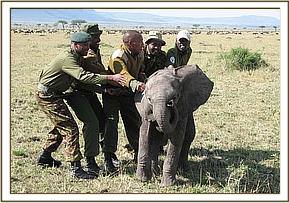

Prognosis
The calf had been injured by the wire cutting right through the neck muscles causing a lot of haemorrhage and pain. But after removing the wire there will be no more irritation and the wound will quickly heal.
Removal of a snare and treatment of a common zebra in Longonot area near Kedong ranch, Naivasha.
This was a case of a male adult zebra that had been sighted with a tight wire snare cutting through the fetlock joint of the left hind leg, it had stayed with the injury for some days and was unable to move and graze at the same rate with other zebras. It was located just by the road side at a GPS location; 37M021747; UTM9911392. It was captured by darting using 5mgs of etorphine hydrochloride combined with 60mgs of xylazine hydrochloride on the right hind thigh.
The wire was then cut, retrieved from the wound and removed completely leaving an extensive raw wound on the limb. The wound was treated using 10% hydrogen peroxide and a tincture of iodine applied topically on it and sprayed using oxytetracycline spray. It was then revived from anaesthesia and released back to the wild after successful treatment. 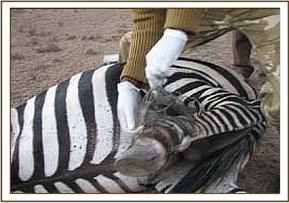
Removal of a snare from a young zebra in game ranch, Naivasha
This was a case of a young female zebra found with a loose wire snare round the neck, the snare had not inflicted any injury on the neck of the animal. It was successfully captured by darting, snare removed then the animal was revived from anaesthesia and released to join the mother. 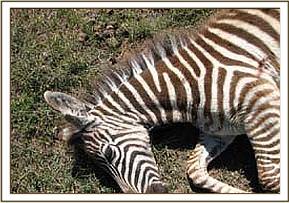
Conclusion
The Central Rift veterinary unit through the support of Kenya Wildlife Service and the David Sheldrick Wildlife Trust (DSWT) responded to as many animals as possible both in the Mara ecosystem and other parts of Central Rift region. During the month of September, one elephant calf that was caught up by a tight wire snare cutting through the neck muscles was successfully captured, desnared and treated. Several zebras were also desnared and treated in Naivasha area as mentioned in this report.
Report by: Dr. Domnic Mijele